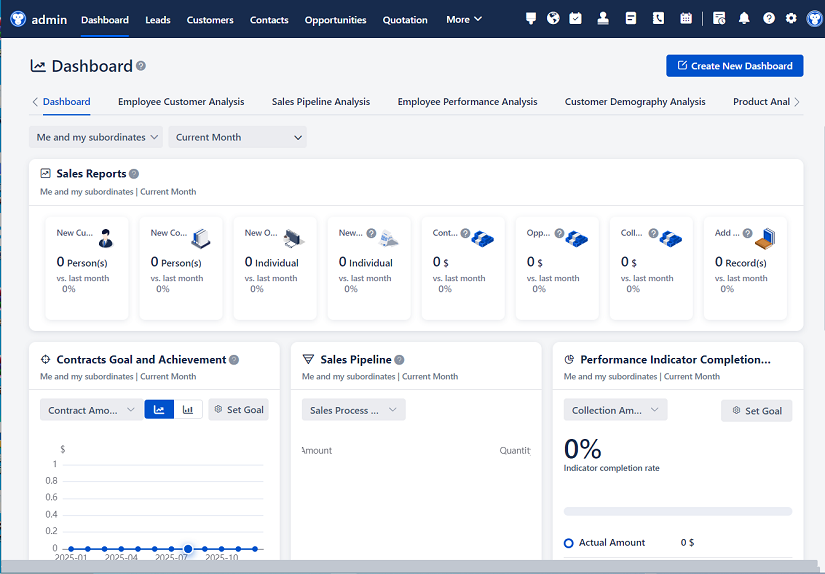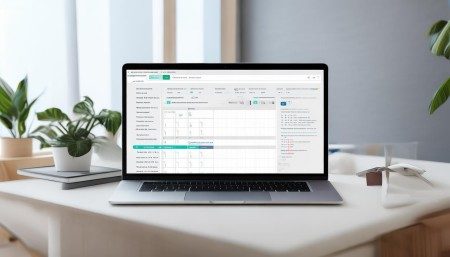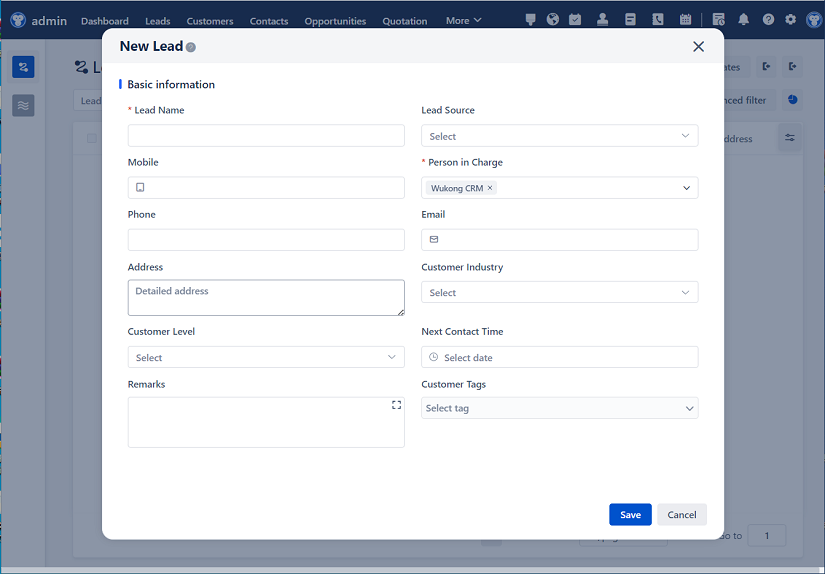
△Click on the top right corner to try Wukong CRM for free
You know, when you're running a startup, every decision feels like it could make or break the whole thing. I mean, seriously—there’s so much to think about: product development, hiring, funding, marketing… and then there’s customer relationship management. It sounds kind of corporate, right? Like something only big companies with fancy offices and endless budgets would care about. But honestly, that couldn’t be further from the truth.
Let me tell you something—I’ve been part of a few early-stage startups, and one thing I’ve learned is that even the tiniest team needs a way to keep track of their customers. Not just names and emails, but conversations, follow-ups, pain points, and feedback. Without that, you’re basically flying blind. And trust me, flying blind in a startup is not a good look.

Now, here’s the thing: you don’t need some massive, bloated CRM system that costs thousands of dollars a month and takes weeks to set up. That’s overkill. What you need is something small, lightweight, and actually useful for a team of, say, five to ten people who are already stretched thin.
So, what exactly makes a CRM “small” and “lightweight”? Well, from my experience, it’s about simplicity. It should be easy to use—like, someone should be able to log in and figure it out in under ten minutes. No complicated training sessions. It should be affordable—ideally under $20 per user per month, or even free for small teams. And it should integrate with tools you’re already using, like Gmail, Slack, or your calendar.
I remember when we first started using a proper CRM at my last startup. We were using spreadsheets before that—Google Sheets, mostly. And sure, it worked… kind of. But as soon as we hit 50 leads, things started falling through the cracks. Emails weren’t followed up on, meetings got double-booked, and we had no idea who had already been pitched what. It was a mess.
Then someone suggested HubSpot’s free CRM. At first, I was skeptical. I mean, “free” and “CRM” in the same sentence? That sounds too good to be true. But we gave it a shot, and honestly, it was a game-changer. It synced with our Gmail, pulled in contacts automatically, and let us track deals in a simple pipeline. Plus, it was completely free for the basic version.
Now, HubSpot isn’t the only option out there. There’s Zoho CRM, which is also pretty solid for small teams. It’s got a clean interface, decent automation features, and their free plan covers up to three users. That’s perfect if you’re just starting out with a tiny core team.
Then there’s Streak, which is actually built right into Gmail. I know that sounds weird, but hear me out. If your team lives in Gmail anyway, why not use a CRM that sits right inside your inbox? Streak lets you track emails, set reminders, and manage pipelines without ever leaving your email. It’s super lightweight and intuitive. We used it for a while before switching to something more robust, and it worked surprisingly well.
Another one I’ve heard great things about is Pipedrive. It’s built specifically for sales teams, and the interface is all about visual pipelines. You literally drag and drop deals from one stage to the next. It’s satisfying to use, and it keeps everyone on the same page. Plus, their pricing is pretty startup-friendly—starts at around $15 per user per month.
But here’s the thing—not every CRM is going to fit every team. You’ve got to think about your workflow. Are you doing a lot of cold outreach? Then you might want something with good email tracking and automation. Are you managing complex client onboarding? Maybe you need custom fields and task assignments. It’s not one-size-fits-all.
And let’s talk about mobile access. I can’t tell you how many times I’ve been on the go—grabbing coffee, hopping between meetings—and needed to quickly check a client note or update a deal status. A good lightweight CRM should have a solid mobile app. HubSpot and Pipedrive both have great ones. Zoho’s is okay, but not as polished.
Another thing people don’t always think about is onboarding. When you’re a small team, time is everything. You can’t afford to spend days setting up a system. That’s why I love tools that let you import contacts from Gmail or CSV files with just a few clicks. And bonus points if they have templates or pre-built workflows. HubSpot, for example, has these little “playbooks” that guide you through common sales processes. It’s like having a coach built into the software.
Now, I know some of you might be thinking, “But won’t a simple CRM limit us as we grow?” That’s a fair concern. And look, no tool is perfect forever. You might outgrow it in a year or two. But here’s the thing: that’s a good problem to have. If you’re outgrowing your CRM, it means your startup is growing. And at that point, you’ll have the resources to invest in something more advanced.

In the meantime, a lightweight CRM gives you structure without slowing you down. It helps you stay organized, follow up consistently, and actually understand your sales process. And that’s huge when you’re trying to build something from nothing.

I’ll never forget the first time we closed a deal using our CRM pipeline. We had all the notes in one place, knew exactly where the lead was in the process, and didn’t have to scramble to remember what we’d promised. It felt professional. It felt like we were actually running a real business.
And that’s the real value of a small CRM—not just the features, but the confidence it gives you. You’re not just guessing anymore. You’ve got data, you’ve got visibility, and you’ve got control.
Oh, and let’s not forget about collaboration. When your whole team is using the same system, it’s way easier to hand off leads, share feedback, or jump in when someone’s out sick. No more “Wait, who was that client again?” moments. Everyone’s on the same page.
One thing I’d caution against, though, is over-customizing too early. I’ve seen teams spend hours tweaking fields and workflows before they even have ten customers. Just start simple. Use the default pipeline. Add a few custom fields if you really need them. You can always adjust later.

And don’t forget about security. Even if you’re a small team, you’re handling customer data. Make sure your CRM uses encryption, has strong password policies, and offers two-factor authentication. Most reputable ones do, but it’s worth checking.
At the end of the day, a lightweight CRM isn’t about replacing human connection—it’s about supporting it. It’s not meant to make your team robotic or salesy. It’s there to help you build better relationships by remembering the details that matter.
So, if you’re a startup team and you’re still using spreadsheets or sticky notes to manage your customers… do yourself a favor. Try out a small CRM. Pick one that’s easy, affordable, and fits your workflow. Give it a month. See how it feels.
I bet you’ll wonder why you didn’t start sooner.
FAQs (Frequently Asked Questions)
Q: Can a free CRM really handle a growing startup?
A: Absolutely—it depends on your needs. Free CRMs like HubSpot or Zoho can handle hundreds of contacts and basic pipelines. They’re perfect for early-stage startups. You can always upgrade later.
Q: Do I need technical skills to set up a lightweight CRM?
A: Nope. Most of these tools are designed for non-techies. You can usually get started in under an hour—just sign up, import your contacts, and go.
Q: What if my team hates using CRMs?
A: That’s common. The key is to pick one that’s so easy and useful they won’t even think of it as “extra work.” Start with something simple like Streak or HubSpot, and show them how it saves time.
Q: Can I integrate a small CRM with other tools like Slack or Google Calendar?
Yes, most lightweight CRMs offer integrations with popular tools. HubSpot, Pipedrive, and Zoho all connect with Gmail, Slack, Zoom, and more.
Q: How do I choose between HubSpot, Zoho, and Pipedrive?
Think about your priorities. HubSpot is great for marketing and sales alignment. Zoho is super customizable. Pipedrive is ideal if you want a visual sales pipeline. Try free versions of each and see what clicks with your team.
Q: Will a CRM help us close more deals?
Not magically—but it helps you stay organized, follow up faster, and avoid missed opportunities. That usually leads to better conversion rates over time.
Q: Is it worth paying for a CRM if there are free options?
Sometimes. Free versions are great to start, but paid plans often include automation, reporting, and support that can save you hours each week. If you’re serious about scaling, the investment usually pays off.
Q: Can I use a CRM for customer support too?
Some can. HubSpot, for example, has basic support ticket features. But if support is a big part of your workflow, you might want to pair your CRM with a dedicated tool like Zendesk or Intercom.
Q: How long does it take to see results after implementing a CRM?
Most teams notice improvements in organization and follow-up within a few weeks. Real sales impact might take a couple of months as data builds up and processes improve.
Q: What’s the biggest mistake startups make with CRMs?
Overcomplicating it. Don’t build 20 custom fields on day one. Start simple, use it consistently, and evolve as you learn what works for your business.
Related links:
Free trial of CRM
Understand CRM software
AI CRM Systems

△Click on the top right corner to try Wukong CRM for free